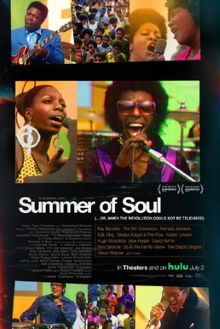I guess this makes two films this week that are about history. This is a documentary about a music festival that took place over six weekends in the summer of 1969 in Harlem, New York City. Since one of the Sundays was concurrent with the much better known Woodstock Festival, this event was at times marketed as being Black Woodstock. However despite the presence of many famous performers and a large attendance of mainly black people, the event was little known to most of the US or the world. This film shows how it was a formative, life-changing event for many of the attendees but afterwards it disappeared from the public consciousness and even this footage of it languished unseen.
The 1960s were an eventful decade for blacks in the US. The assassination of Martin Luther King Jr. in 1968 led to nationwide riots and there were fears of similar trouble during the hot summer of 1969. Singer and community organizer Tony Lawrence managed to bring together sponsors and famous musicians such as B.B. King, Nina Simone, Stevie Wonder, Mahalia Jackson etc. plus obtain the support of New York City MayorJohn Lindsay to hold the music festival to help forestall tensions and give black people something of their own to be proud of. The New York Police Department refused to provide security so that was instead handled by the Black Panthers. The series of concerts was a tremendous success, attracting crowds of up to 50,000 people and were held peacefully. Footage of the festival was shot but were mostly unused except for two television specials. This documentary was made after many years of failed efforts to digitize and restore the footage.
Not being a particular aficionado of music, most of the performers who appear here are unknown to me. In any case, this being only a two-hour film, it offers only snippets of the performances so I’d argue that it is really about the festival as a cultural phenomenon and the lasting impression it left on the attendees. It still is amazing to watch a very young Stevie Wonder and realize how truly talented he is when most of us might only know him for one song or be overwhelmed by the outpouring of raw emotion of a gospel singer like Mahalia Jackson. There’s diversity too with groups like The 5th Dimension performing psychedelic music, Hugh Masekela bringing the sounds of South Africa and Ray Barretto whose appearance here introduces to me the portmanteau word Nuyorican. All of the music is great even if my appreciation of it is constrained by my lack of familiarity.
I have no idea how accurate some of the claims made by the interviewees here are about the festival’s impact but I suppose they are truthful at least to some extent. Among other claims, they credit it for accelerating the transition from the word “negro” to the word “black” and for nurturing the aesthetic sense that black can be beautiful and something to be proud of. I can certainly see how powerful an experience it must have been for young blacks to see for themselves how many of them there are in New York, how they are just regular people trying to make a life for themselves and how rich their culture can be. Perhaps even more than watching the musical performances, the real joy of this film is watching the crowd sing and dance, just having a good time in the hot summer.
As this comes from a cultural background so far removed from my own, there is unfortunately only so much that I can get from this documentary. For those with even less emotional investment, I suspect this might even be boring at times so your mileage may vary. I do agree that the disappearance of this footage and how such a massive event would later be almost completely forgotten about amounts to black erasure as the still white-dominated mainstream media of the time preferred not to pay attention to or even think about a black cultural phenomenon that is both positive and exists independently of white people. It’s great to see this reemerge into the light of day and its place in American history restored.
